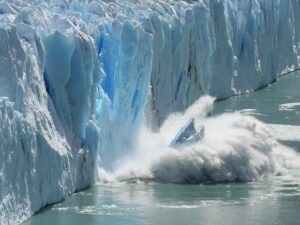The world’s largest iceberg, A23a is disintegrating into thousands of smaller ice chunks, posing environmental and navigational threats in the Southern Ocean. NASA’s Aqua satellite, using its MODIS instrument, captured striking images of this slow-motion collapse near South Georgia Island, where the iceberg is currently grounded.

A23a with a surface area once estimated at 1,200 square miles roughly the size of South Georgia Island has been slowly breaking apart via a process called “edge wasting.” Since becoming lodged again in March, the massive sheet has already lost nearly 200 square miles of ice. NASA reports that the largest fragment so far, dubbed A23c, spans around 50 square miles, while many other splintering pieces still stretch over a kilometre across, making them dangerous obstacles for ships in the area.
“The ocean surrounding the main berg is littered with thousands of ice shards, creating a scene reminiscent of a dark, starry night,” NASA noted in a statement accompanying the satellite images.
A23a originally calved from the Filchner-Ronne Ice Shelf in 1986 but remained trapped in Antarctic ice until it broke free in 2023. After drifting and temporarily stalling in a vortex earlier this year, it now rests off the coast of South Georgia Island in the Scotia Sea a region known as an “iceberg graveyard,” where massive icebergs typically melt away or disintegrate.
The iceberg’s fragmentation could significantly impact local wildlife. South Georgia Island is home to more than two million penguins, as well as seals and seabirds. The grounded iceberg could disrupt normal feeding routes, forcing penguins to travel farther to find food. Scientists are also concerned that meltwater from A23a could alter the temperature and salinity of nearby waters, affecting the ecosystem’s delicate balance.
Despite these concerns, some researchers see a possible ecological silver lining. As the iceberg melts, it could release valuable nutrients into the ocean, potentially benefiting marine life in the region.
But the broader warning is clear: the breakup of A23a is not an isolated incident. Scientists caution that as climate change accelerates, massive calving events like this one may become more frequent. The melting of ice shelves not only threatens local ecosystems and navigational safety but also contributes to rising sea levels and alters ocean circulation patterns, with global consequences.
As A23a continues to shed chunks of ice and drift slowly toward its eventual dissolution, the eyes of the scientific world remain fixed on its journey both as a symbol of our warming world and a living experiment in climate disruption.
